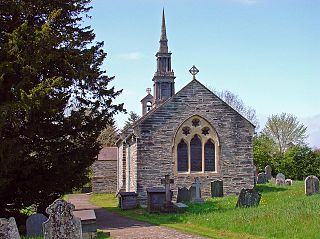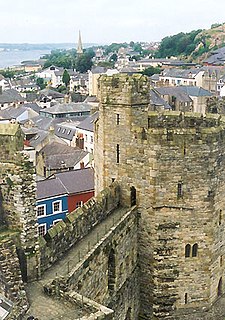
Blaenau Ffestiniog is a town in Gwynedd, Wales. Once a slate mining centre in historic Merionethshire, it now relies much on tourists, drawn for instance to the Ffestiniog Railway and Llechwedd Slate Caverns. It reached a population of 12,000 at the peak development of the slate industry, but fell with the decline in demand for slate. The population of the community, including the nearby village Llan Ffestiniog, was 4,875 in the 2011 census: the fourth most populous in Gwynedd after Bangor, Caernarfon and Llandeiniolen. The population not including Llan is now only about 4,000.

The Baptist Union of Wales is a fellowship of Baptist churches in Wales.

Llangoedmor is a village 2 miles east of Cardigan, Ceredigion, Wales.

Llangynog is a village and community at the confluence of the Afon Eirth and the Afon Tanat at the foot of the Berwyn range in north Powys, Wales.

Cilcain is a village and community, near Mold in Flintshire, north-east Wales. The village has an industrial history and includes the Millennium Woods, a post office, a public house, a parish church, a primary school and a village hall.

The media in Wales provide services in both English and Welsh, and play a role in modern Welsh culture. BBC Wales began broadcasting in 1923 have helped to promote a form of standardised spoken Welsh, and one historian has argued that the concept of Wales as a single national entity owes much to modern broadcasting. The national broadcasters are based in the capital, Cardiff.
Clwb Pêl Droed Llanfairpwllgwyngyllgogerychwyrndrobwllllantysiliogogogoch Football Club, commonly referred to by a shortened version as CPD Llanfairpwll FC, is a football team based in Llanfairpwllgwyngyllgogerychwyrndrobwllllantysiliogogogoch, that plays in the North Wales Coast West Football League, the 5th level of the Welsh football league system, since the 2020–21 season.

The Hundred of Dungleddy was a hundred in the centre of Pembrokeshire, Wales. It had its origins in the pre-Norman cantref of Deugleddyf. It derives its Welsh name from its position between the two branches of the River Cleddau (Cleddyf): the English form is a corruption of the Welsh. The area of the cantref was around 185 km2: it was the smallest of the seven cantrefi of Dyfed.

Llanycrwys is a community located in Carmarthenshire, Wales. Situated in the historical Cayo Hundred in the Union of Lampeter, it is situated near the River Cothi, and is separated from the parish of Caio by the Afon Twrch, which flows near the St. Davids church. The church is isolated, and was restored in 1892 by C. H. Purday of Ewan Christian, who had a porch on the western side, with a timbered gable.

Llanfaes is a small village on the island of Anglesey, Wales, located on the shore of the eastern entrance to the Menai Strait, the tidal waterway separating Anglesey from the north Wales coast. Its natural harbour made it an important medieval port and it was briefly the capital of the kingdom of Gwynedd. Following Prince Madoc's Rebellion, Edward I removed the Welsh population from the town and rebuilt the port a mile to the south at Beaumaris. It is in the community of Beaumaris.

The place-names of Wales derive in most cases from the Welsh language, but have also been influenced by linguistic contact with the Romans, Anglo-Saxons, Vikings, Anglo-Normans and modern English. Toponymy in Wales reveals significant features of the country's history and geography, as well as the development of the Welsh language. Its study is promoted by the Welsh Place-Name Society.

Llanfechain is a village and community in Powys, Wales, on the B4393 road between Llanfyllin and Llansantffraid-ym-Mechain. Historically it belonged to Montgomeryshire. The River Cain runs through. The population of 465 at the 2011 Census was estimated at 476 in 2019.
Llan and its variants are a common element of Celtic placenames in the British Isles and Brittany, especially of Welsh toponymy. In Welsh, an name of a local saint or a geomorphological description follows the Llan morpheme to form a single word: for example Llanfair is the parish or settlement around the church of St. Mair. Whereas, Goidelic toponyms end in -lann.

The Cambrian News is a weekly newspaper distributed in Wales. It was founded in 1860 and is based in Cefn Llan Science Park, Aberystwyth. Cambrian News Ltd was bought by media entrepreneur Sir Ray Tindle in 1998.

Ysbyty Ystwyth is a small village and community in Ceredigion, Wales 13 mi (21 km) south-southeast of Aberystwyth. Its church and the parish of the same name were the property of the Order of the Knights of the Hospital of St John of Jerusalem, hence the 'Ysbyty' in the title, which never was a hospice for travellers to Strata Florida. The community includes the hamlet of Pont-rhyd-y-groes. The area is situated in the Desert of Wales and is wild country. The peak of Llan Ddu Fawr is located in the area and the lakes Llyn Fyrddon Fawr and Fach.

Llanfairpwllgwyngyll, or Llanfair Pwllgwyngyll, is a large village and local government community on the island of Anglesey, Wales, on the Menai Strait next to the Britannia Bridge and across the strait from Bangor. Both shortened and lengthened (Llanfairpwllgwyngyllgogerychwyrndrobwllllantysiliogogogoch) forms of the placename are used in various contexts.

Townships in Montgomeryshire are divisions of the ancient parishes of the county of Montgomery. In 1539 townships were grouped together in Hundreds. The Townships which were recognised were based on the older Welsh divisions of Tref, or plural Trefi, which had formed the Welsh administrative districts of the Commote. Not all of the former Tref were recognised and some smaller trefi were amalgamated into larger townships. A township was allocated to a particular parish, but townships were recognised as administrative districts, rather than the parishes.
Mari Gwendoline Ellis, was a Welsh writer and women's rights activist.

Evan Thomas Davies, also known by the pseudonym "Dyfrig", was a Welsh priest. After completing his education at the school in Ystrad Meurig he moved to study at St David's College, Lampeter, graduating in 1869. He then spent the next year teaching, at Greenock, before, in 1870 being ordained Deacon, and, in 1871, ordained Priest. For a while he was appointed Curate of Llanwynno, and later of Betws, Glamorganshire. In 1875, he moved to take up an appointment at St David's Welsh Church, Brownlow Hill, Liverpool, before, in 1882, becoming vicar of Aberdyfi, and then, in 1890, of Pwllheli. In 1906 he was appointed Vicar of Llanfihangel Ysgeifiog in Anglesey, where he remained until he retired in 1913. He also served as Rural Dean of Llŷn, and as Residentiary Canon of Bangor Cathedral.
















